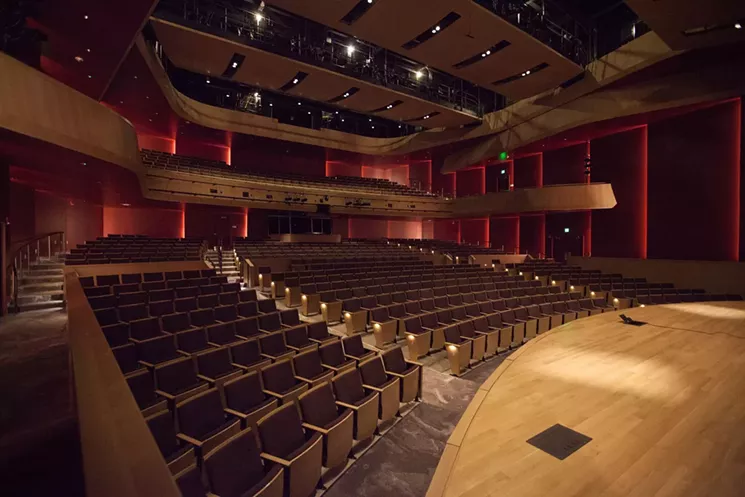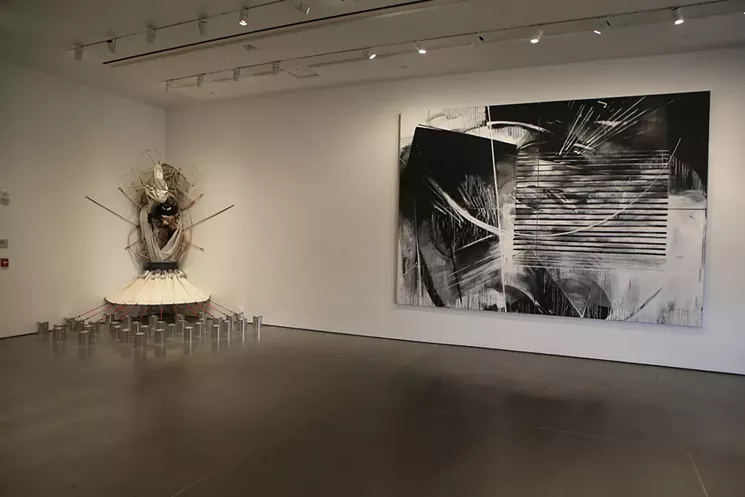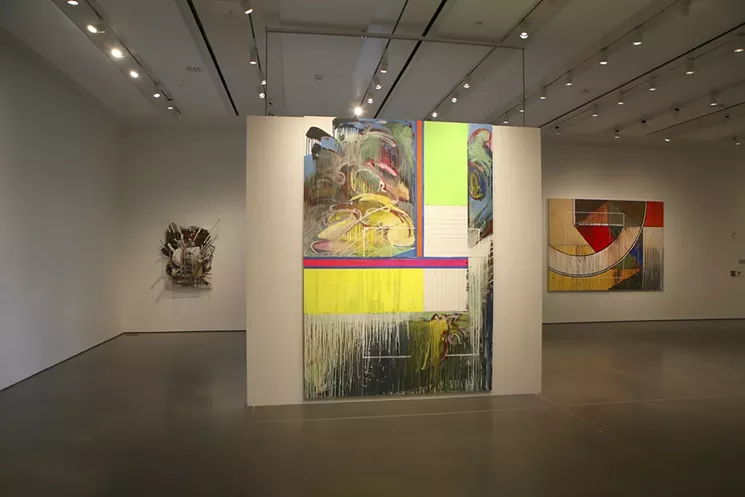Uccs How to Get to Ent Fine Arts Building
The Kirkland Museum of Fine & Decorative Art isn't the only recent addition to the Forepart Range art scene. The $seventy meg Ent Center for the Arts opened last month on the University of Colorado Colorado Springs campus, and the facility is equally impressive equally its inaugural show, a solo defended to Floyd D. Tunson of Manitou Springs, one of the most important artists working in Colorado.
The 92,000-square-foot building sits on a rise above the busy intersection of Due north Nevada Avenue and Austin Bluffs Parkway. This is at the extreme southwestern corner of the campus, its virtually loftier-profile site in terms of traffic, and the Ent Center deserves the attention. Created by Denver's Semple Brown Design together with New York's H3 Hardy Collaboration Architecture, a specialist in the design of arts centers, the structure was conceived equally an exaggerated horizontal with an undulating, south-facing facade of enormous curving glass walls and shiny silver cladding that looks like titanium only is really a blended. The wave-like undulations are in chat with each other, swooping in and out, above and below. A contrasting approach is seen on the north-facing rear side, where the internal volumes of the building bump upward and out in a cubic conception. But that continuous facade in front sets the edifice's futuristic tone.
The site blueprint, which too incorporated an existing approach, was conceived past Denver'due south Davis Partnership, and the landscaping was done by Tapis Associates of Colorado Springs. The topography of the campus is extreme, ranging from steep hills to the even steeper bluffs across them, and this spot at the bottom of the hills presented challenges. Without some major land resculpting, the Ent Centre would exist coming up out of the basis on the lower side, so the dirt from the excavations for the foundation was piled up in front. The fill was so turned into terraces held in place by curvilinear walls mirroring the curved elements on the building. The plantings are native grasses, bushes and copse. There are stairs and meandering walkways leading effectually the structure and up to several awe-inspiring sculptures that have turned the backyard into a full-fledged sculpture garden.

Floyd D. Tunson'due south "Untitled 147" (left), "Untitled 140," both acrylic on canvas.
Tom Kimmell
I walked around and through the Ent Center with Daisy McGowan, managing director of the Galleries of Gimmicky Art that are housed in the building and in a satellite space downtown. She assembled the sculptures on view outside, most of which are on temporary, two-year loans through an initiative called Art WithOut Limits. Just they could — and should — be made permanent fixtures.
The standouts are a trio of remarkable metal spires, two with kinetic features, ready in a regular rhythm across the lawn. These pieces wait and so contemporary and are then in keeping with the building's graphic symbol, you lot'd think they were custom-made — but the artist, the legendary Starr Kempf, died nearly 25 years ago. Also compelling is Linda Fleming's large, linear sculpture well-nigh the street at the bottom of the hill, in which bands of rusting steel outline a sphere with arching legs. According to McGowan, in a few months one of Fleming's pierced-screen sculptures volition be installed at the superlative, close to the building. Both Kempf and Fleming have long been recognized equally masters of Colorado art.

The Shockley-Zalabak Theater at the Ent Heart for the Arts.
Courtesy of the University of Colorado Colorado Springs
Ent, which gave a $12 one thousand thousand donation to the project (hence its name), is a well-known fiscal institution in Colorado Springs, and before the sculptures were installed, many passersby idea the new construction would be a banking company, McGowan says. Only given the theatricality of the building'due south volumes and with the sculptures now in place, information technology's readily credible that the Ent Center is a cultural institution.
The main archway at the southeast corner of the edifice leads into the m Murray and Betty Ross Vestibule, which has curved window walls that have in the imperial views of Pikes Elevation; it'due south articulate that the architects placed the walls to frame the stunning views. The lobby feeds into the very impressive Shockley-Zalabak Theater, which seats nearly 800, has a full-fledged fly-house over the stage and boasts adjustable panels on the ceiling that tin be tuned acoustically. Facilities for music, theater and dance take up most of the interior; other performance spaces include the Chapman Foundations Recital Hall, reserved for classical music, and the Dusty Loo Bon Vivant Theater, home to the resident TheatreWorks troupe. There are also rehearsal halls, studios and workshop rooms for UCCS classes.

"Homage to Senga," mixed materials, and "Untitled 111," acrylic on canvas, both by Floyd D. Tunson.
Tom Kimmell
The fine art component that begins in the sculpture garden picks up again just off the main foyer, in the broad, double-elevation corridor. Hanging from the ceiling are skeletal rowboats from Tunson's "Haitian Dreamboat" series, which refer to Haitian refugees headed for Florida in a ramshackle flotilla. Although they foreshadow Floyd D. Tunson: Janus, the debut evidence at the Ent, they are non a part of that solo and volition remain in place after the showroom comes downwardly.

(Left to Correct) "Synchromesh 49," mixed materials, "Untitled 142" and "Untitled 141," both acrylic on canvas, all by Floyd D. Tunson.
Tom Kimmell
Tunson works in a wide range of approaches, from neo-pop pieces with African-American content to abstracts. McGowan focused on the latter in Janus. The evidence starts in the small foyer just outside the 2,500-square-foot Marie Walsh Sharpe Gallery, where McGowan has placed a single big painting next to the entry. Inside, viewers are invariably drawn to the 42-foot-long "Untitled 147"; the enormous slice covers the expansive wall to the left. On multiple panels, Tunson has clustered rounded and stone-like colored shapes and mounded dots; on peak of them, he'due south painted a broad, flowing white line that turns in on itself repeatedly equally it runs across the entire length. Tunson created the mural in sections last yr and told McGowan that he had never seen information technology put together until he hung it at the Ent Heart. In a somewhat different vein is the unusual corner installation "Homage to Senga," in which Tunson salutes Senga Nengudi, an internationally known conceptual artist who lives in Colorado Springs. Nengudi is interested in manipulating tensile features, and Tunson uses bungees to concord up the sculptural elements here, equally well as to hold out a canvas brim that extends like a awning. The evidence also includes a grouping of other big abstracts and semi-abstracts.
Tunson was an inspired pick to introduce the new Sharpe gallery — and, by extension, the Ent Center itself. With this evidence and the Kempfs and the Fleming outside, the place is virtually a master class in Colorado art.
Floyd D. Tunson: Janus, through April 15, Ent Center for the Arts, 5225 Northward Nevada Avenue, Colorado Springs, 719-255-8227, galleryuccs.org.
Source: https://www.westword.com/arts/ent-centers-inaugural-floyd-tunson-show-as-impressive-as-building-10104772
Post a Comment for "Uccs How to Get to Ent Fine Arts Building"